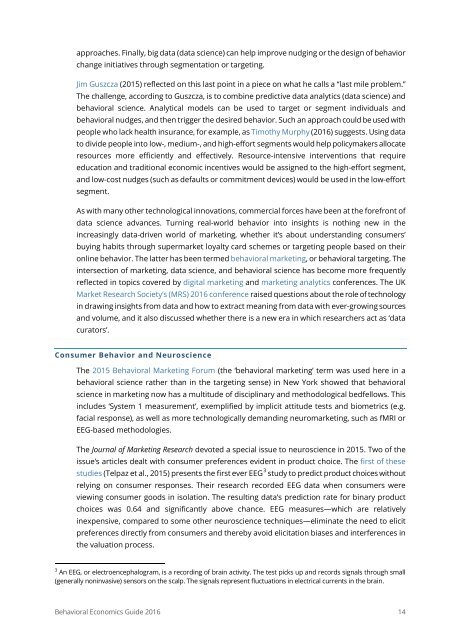THE BEHAVIORAL ECONOMICS GUIDE 2016
BEGuide2016
BEGuide2016
Create successful ePaper yourself
Turn your PDF publications into a flip-book with our unique Google optimized e-Paper software.
approaches. Finally, big data (data science) can help improve nudging or the design of behavior<br />
change initiatives through segmentation or targeting.<br />
Jim Guszcza (2015) reflected on this last point in a piece on what he calls a “last mile problem.”<br />
The challenge, according to Guszcza, is to combine predictive data analytics (data science) and<br />
behavioral science. Analytical models can be used to target or segment individuals and<br />
behavioral nudges, and then trigger the desired behavior. Such an approach could be used with<br />
people who lack health insurance, for example, as Timothy Murphy (<strong>2016</strong>) suggests. Using data<br />
to divide people into low-, medium-, and high-effort segments would help policymakers allocate<br />
resources more efficiently and effectively. Resource-intensive interventions that require<br />
education and traditional economic incentives would be assigned to the high-effort segment,<br />
and low-cost nudges (such as defaults or commitment devices) would be used in the low-effort<br />
segment.<br />
As with many other technological innovations, commercial forces have been at the forefront of<br />
data science advances. Turning real-world behavior into insights is nothing new in the<br />
increasingly data-driven world of marketing, whether it’s about understanding consumers’<br />
buying habits through supermarket loyalty card schemes or targeting people based on their<br />
online behavior. The latter has been termed behavioral marketing, or behavioral targeting. The<br />
intersection of marketing, data science, and behavioral science has become more frequently<br />
reflected in topics covered by digital marketing and marketing analytics conferences. The UK<br />
Market Research Society’s (MRS) <strong>2016</strong> conference raised questions about the role of technology<br />
in drawing insights from data and how to extract meaning from data with ever-growing sources<br />
and volume, and it also discussed whether there is a new era in which researchers act as ‘data<br />
curators’.<br />
Consumer Behavior and Neuroscience<br />
The 2015 Behavioral Marketing Forum (the ‘behavioral marketing’ term was used here in a<br />
behavioral science rather than in the targeting sense) in New York showed that behavioral<br />
science in marketing now has a multitude of disciplinary and methodological bedfellows. This<br />
includes ‘System 1 measurement’, exemplified by implicit attitude tests and biometrics (e.g.<br />
facial response), as well as more technologically demanding neuromarketing, such as fMRI or<br />
EEG-based methodologies.<br />
The Journal of Marketing Research devoted a special issue to neuroscience in 2015. Two of the<br />
issue’s articles dealt with consumer preferences evident in product choice. The first of these<br />
studies (Telpaz et al., 2015) presents the first ever EEG 3 study to predict product choices without<br />
relying on consumer responses. Their research recorded EEG data when consumers were<br />
viewing consumer goods in isolation. The resulting data’s prediction rate for binary product<br />
choices was 0.64 and significantly above chance. EEG measures—which are relatively<br />
inexpensive, compared to some other neuroscience techniques—eliminate the need to elicit<br />
preferences directly from consumers and thereby avoid elicitation biases and interferences in<br />
the valuation process.<br />
3 An EEG, or electroencephalogram, is a recording of brain activity. The test picks up and records signals through small<br />
(generally noninvasive) sensors on the scalp. The signals represent fluctuations in electrical currents in the brain.<br />
Behavioral Economics Guide <strong>2016</strong> 14


